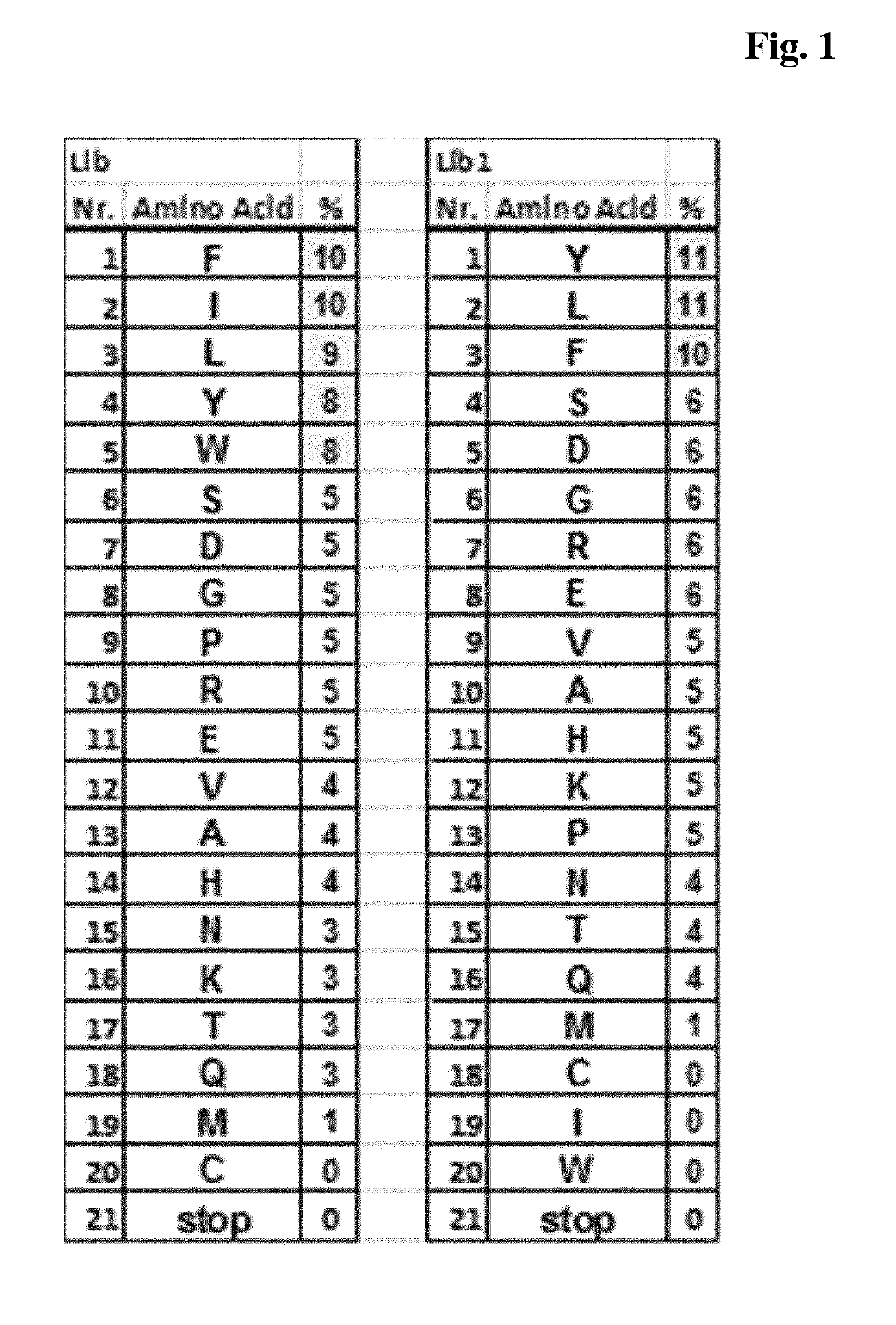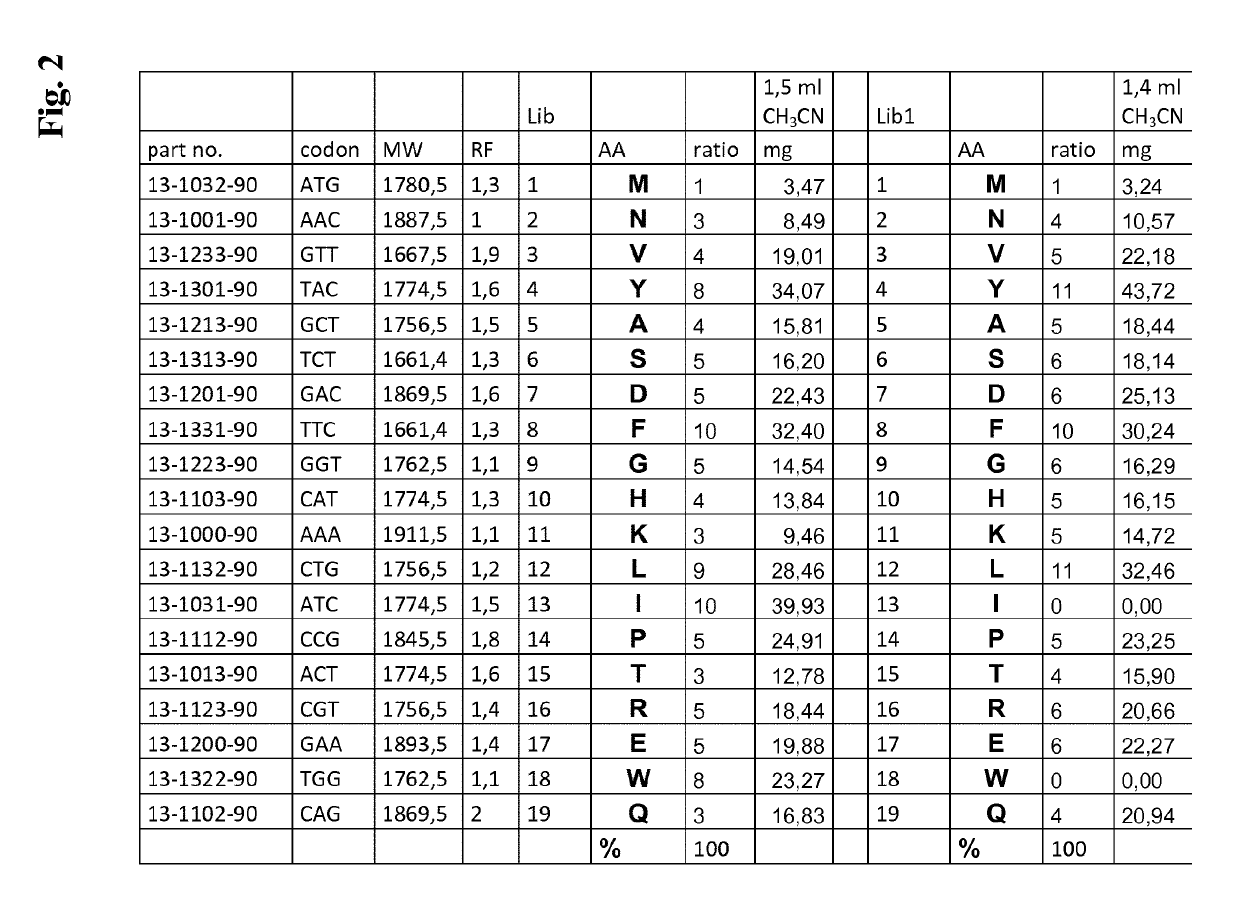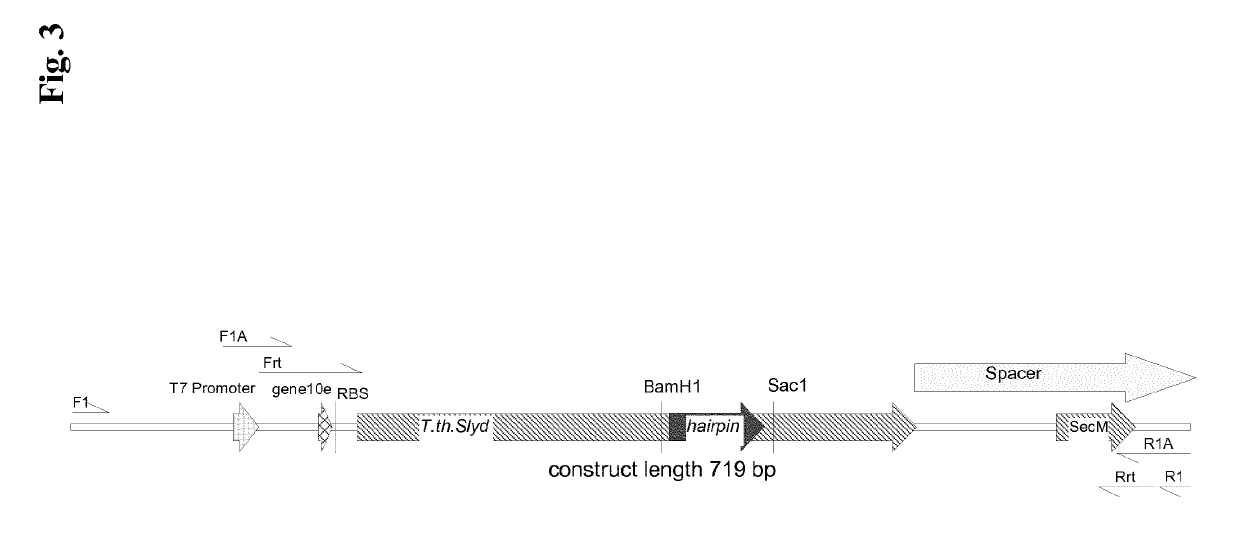Nucleic acids encoding chimeric polypeptides for library screening
a technology of chimeric polypeptides and nucleic acids, applied in the direction of peptides, nucleotide libraries, chemistry apparatus and processes, etc., can solve the problem of polypeptides' intrinsic flexibility
- Summary
- Abstract
- Description
- Claims
- Application Information
AI Technical Summary
Benefits of technology
Problems solved by technology
Method used
Image
Examples
example 1
[0351]Synthesis of a DNA Sequence Encoding a Variable Sequence with a Selected Subset of Naturally Occurring Amino Acid Residues
[0352]A library of 97 bp single-stranded linear DNA fragments comprising a variable sequence encoding an amino acid sequence of 13 amino acids was synthesized by making use of established state-of-the-art phosphoramidite chemistry. The DNA fragment was a fragment with a contiguous nucleotide sequence according to formula III
5′-UD—OD—ZD-3′ (formula III),
wherein UD, OD, and ZD were linked by phosphodiester bonds.
[0353]UD was 5′-CGA CAG TGT GGC GCA GGA TCC-3′ comprising a BamHI site (SEQ ID NO:18) and serving as a binding site for a complementary forward primer.
[0354]ZD was 5′-GGG AGC TCG CAG GAG ACG TAG C-3′ comprising a SacI site (SEQ ID NO:19) and serving as a binding site for a complementary reverse primer.
[0355]OD was a variable sequence according to the formula IV
5′-(Lib-Lib1)6-Lib-3′ (formula IV).
[0356]Lib was a first mixture of trinucleotides, wherei...
example 2
[0363]Ribosome Display with the Thermus thermophilus SlyD FKBP Domain, Positive Control Experiment
[0364]First, the basic suitability of the Thermus thermophilus SlyD FKBP scaffold for the purpose of ribosome display selections was shown. A 719 bp Ribosome Display DNA Fragment was designed and synthesized. The 360 bp Thermus thermophilus SlyD FKBP sequence is under the control of a T7 promotor and gene10 RBS (ribosome binding site) regulatory sequences. A 84 bp sequence replaces the Insert in Flap Domain by the a sequence motif encoding a peptide hairpin, which is an antibody target motif. Downstream of the Thermus thermophilus SlyD FKBP sequence a 189 bp, stop-codon-less ribosome display spacer is fused. The spacer is basically designed according to Mattheakis, L. C. et al. PNAS 91 (1994) 9022-9026, but additionally contains the SecM translational stalling sequence (Nakatogawa, H. and K. Ito Cell 108 (2002) 629-636; Gumbart, J. et al. Biophys J 103 (2012) 331-341). At the 3′-end of ...
example 3
[0372]Example Amplification of the Ribosome Display Construct, Positive Control Experiment
[0373]The ribosome display construct of Example (foregoing) was PCR-amplified as follows. 100 μL PCR reaction contained 0.2 mM dNTPs (10 mM stock, dNTPmix, Roche Diagnostics, Mannheim, Germany), 2.5 units PWO Polymerase (100 units stock, Roche Diagnostics, Mannheim, Germany), 0.25 μM Primer F1 and 0.25 μM Primer R1; 1× PWO PCR buffer (Roche Diagnostics, Mannheim, Germany) and 25 ng fragment DNA template. The PCR profile was as follows: 5 min 95° C., (2 min 94° C., 45 sec 57° C., 45 sec 72° C.)×25, 5 min 72° C.,∞4° C. The appropriate length of a 3 μl aliquot of the PCR reaction product was confirmed by analytical agarose gel electrophoresis. The PCR product was then resolved in a 3% GelRed (Biotium) stained agarose gel and the target DNA-band was extracted from the gel using the Qiagen Gel Extraction Kit II according to the manufacturer's instructions.
[0374]The combined cell-free transcription a...
PUM
| Property | Measurement | Unit |
|---|---|---|
| Fraction | aaaaa | aaaaa |
| Fraction | aaaaa | aaaaa |
| Fraction | aaaaa | aaaaa |
Abstract
Description
Claims
Application Information
 Login to View More
Login to View More - R&D
- Intellectual Property
- Life Sciences
- Materials
- Tech Scout
- Unparalleled Data Quality
- Higher Quality Content
- 60% Fewer Hallucinations
Browse by: Latest US Patents, China's latest patents, Technical Efficacy Thesaurus, Application Domain, Technology Topic, Popular Technical Reports.
© 2025 PatSnap. All rights reserved.Legal|Privacy policy|Modern Slavery Act Transparency Statement|Sitemap|About US| Contact US: help@patsnap.com



